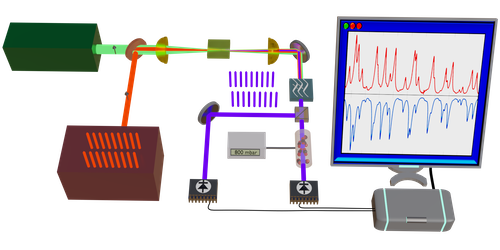A Quick Way to Measure Isotope Ratios
Measuring the relative abundance in a material of two isotopes of the same element can provide clues about how old the material is, where it came from, and what interactions it had with its surroundings. To tease out such isotope ratios, researchers typically use a technique called mass spectroscopy. But mass spectrometers are costly and using them can require that the sample be pretreated. The technique also requires minutes-long measurements. Now, Alexandre Parriaux of the University of Burgundy, France, and his colleagues report a way to measure isotope ratios in just a few tens of seconds [1]. Their method offers promise for real-time gas isotope ratio measurements with high spectral resolution, and it could lead to miniaturized and portable instruments.
For their method, the team designed and built a so-called dual-comb spectroscope, which measures the spectral response of a sample to two interfering laser “combs”—laser sources whose spectra are made of equally spaced frequency lines. The technique has been used for measuring trace atmospheric gases and volatile organic compounds, but it remained untested for isotope-ratio measurements.
For their demonstration, the team used the spectrometer to measure the ratio of different carbon isotopes in carbon dioxide. To do that, they tailored the device so that it analyzed the spectral region around 4.36 m, a wavelength where carbon isotopologues (molecules that only differ in their isotopic composition, for example, and ) have strong absorption features. After calibrating the system, they filled a 10-cm-long cell with a mixture of carbon dioxide gas and air, recorded its absorption spectrum with a dual-comb spectrometer, and then used that spectrum to determine the gas’ carbon-isotope ratio. Their measurements showed good agreement with data obtained using a mass spectrometer.
–Rachel Berkowitz
Rachel Berkowitz is a Corresponding Editor for Physics Magazine based in Vancouver, Canada.
References
- A. Parriaux et al., “Isotope ratio dual-comb spectrometer,” Phys. Rev. Research 4, 023098 (2022).




